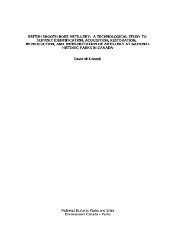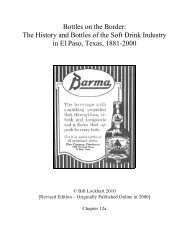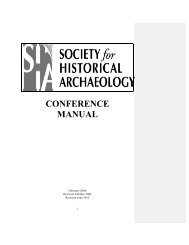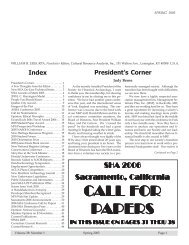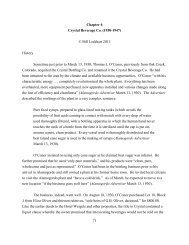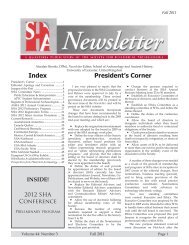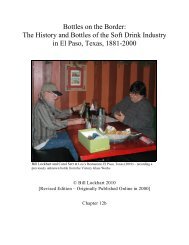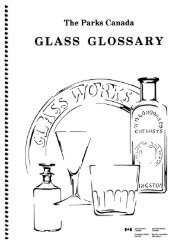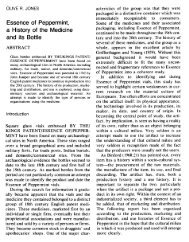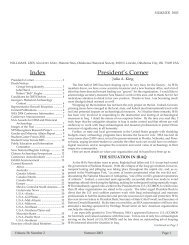Bottles on the Border: The History and Bottles of the Soft Drink ...
Bottles on the Border: The History and Bottles of the Soft Drink ...
Bottles on the Border: The History and Bottles of the Soft Drink ...
You also want an ePaper? Increase the reach of your titles
YUMPU automatically turns print PDFs into web optimized ePapers that Google loves.
Lambrechtsen (2001:8) provides a good descripti<strong>on</strong> from 1819:<br />
<strong>The</strong> water which is imported at L<strong>on</strong>d<strong>on</strong> is brought over in st<strong>on</strong>e bottles, closely<br />
corked <strong>and</strong> cemented c<strong>on</strong>taining about three English pints each, which means <strong>the</strong><br />
water, as l<strong>on</strong>g as <strong>the</strong> comm<strong>on</strong> air is excluded, will retain many <strong>of</strong> its excellent<br />
qualities for several m<strong>on</strong>ths; but this cauti<strong>on</strong> is so necessary, that if too large an<br />
empty space is left even in <strong>the</strong> neck <strong>of</strong> <strong>the</strong> bottle, it so<strong>on</strong> loses in a great degree<br />
<strong>the</strong> brisk, smart, pungent taste, which principally characterised its excellence, <strong>and</strong><br />
is more liable to be injured by keeping than any o<strong>the</strong>r mineral water. <strong>The</strong> water<br />
abounds with an alkaline salt in a much greater quantity than any <strong>of</strong> <strong>the</strong> o<strong>the</strong>r<br />
known mineral waters.<br />
<strong>The</strong> water originated at Selters Spring in Niderselters, Germany, a naturally carb<strong>on</strong>ated<br />
th<br />
spring. According to Webster’s Collegiate Dicti<strong>on</strong>ary (10 ed.), <strong>the</strong> word, seltzer, is derived<br />
from Niderselters. <strong>The</strong> spring was <strong>the</strong> best-known in Germany, <strong>and</strong> waters were exported<br />
th<br />
th<br />
worldwide during <strong>the</strong> 18 <strong>and</strong> 19 centuries. <strong>The</strong> ceramic bottles were manufactured in <strong>the</strong><br />
Westerwald Mountains, known as <strong>the</strong> “jug baking l<strong>and</strong>/district.” Under <strong>the</strong> h<strong>and</strong>le <strong>of</strong> each bottle<br />
is stamped <strong>the</strong> first initial <strong>of</strong> <strong>the</strong> jugmaker’s locati<strong>on</strong> <strong>and</strong> <strong>the</strong> pers<strong>on</strong>’s individual number.<br />
th<br />
Various types <strong>of</strong> st<strong>on</strong>eware bottles were used as early as <strong>the</strong> 13 century, although <strong>the</strong>y were<br />
th<br />
more rounded or “belly shaped.” H<strong>and</strong>les appeared in <strong>the</strong> 17 century, <strong>and</strong> taller, cylindrical<br />
bottles date from about 1850. <strong>The</strong> stamp <strong>on</strong> <strong>the</strong> fr<strong>on</strong>t <strong>of</strong> <strong>the</strong> bottle has g<strong>on</strong>e through several<br />
variati<strong>on</strong>s, <strong>and</strong> bottle necks vary in length (Lambrechtsen 2001:6-7).<br />
Jug-making was a cottage industry in <strong>the</strong> Westerwald area where families in at least nine<br />
villages manufactured <strong>the</strong> Selters bottles. Identificati<strong>on</strong> <strong>on</strong> <strong>the</strong> fr<strong>on</strong>t <strong>of</strong> <strong>the</strong> bottles, such as<br />
Herzogthum Nasau (literally Dutchy <strong>of</strong> Nassau) identify <strong>the</strong> political territory <strong>of</strong> <strong>the</strong> local nobility<br />
or councils that licensed <strong>the</strong> exportati<strong>on</strong> <strong>of</strong> <strong>the</strong> water. Because <strong>of</strong> <strong>the</strong> competiti<strong>on</strong> from glass<br />
th<br />
c<strong>on</strong>tainers, <strong>the</strong> jug trade declined by <strong>the</strong> end <strong>of</strong> <strong>the</strong> 19 century <strong>and</strong> was reduced to 49 jugmakers<br />
by 1926 (Lambrechtsen 2001:6-7).<br />
White Rock Mineral Water<br />
Although Houck & Dieter called <strong>the</strong>ir supplier <strong>the</strong> White Rock Mineral Water Co., <strong>the</strong><br />
bottler termed itself <strong>the</strong> White Rock Mineral Springs Co. Located in Waukesha, Wisc<strong>on</strong>sin,<br />
White Rock produced a carb<strong>on</strong>ated, lithiated water, sarsaparilla, <strong>and</strong> possibly o<strong>the</strong>r flavors. <strong>The</strong><br />
White Rock website (White Rock 2008) includes a history <strong>of</strong> <strong>the</strong> company <strong>and</strong> various versi<strong>on</strong>s<br />
98



